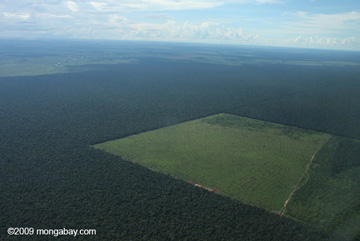A new study in Biological Conservation has shown that edge forests and forest patches are more vulnerable to burning because they are drier than intact forests. Using eight years of satellite imagery over East Amazonia, the researchers found that desiccation (extreme dryness) penetrated anywhere from 1 to 3 kilometers into forests depending on the level of fragmentation.
“Fire is one of the biggest threats to the world’s tropical forests, but in general, rainforests will not burn because they are too moist. But logged forests and edge forest can burn,” tropical ecologist Susan Laurance, one of the study’s authors, told mongabay.com. “We now think we understand why this happens. During the dry season these forests near the edge are drying out increasing their vulnerability to fires, whereas intact rainforests do not dry out over the same period.”
The study also found that the age of the deforestation and fragmentation made a difference. Younger edge forests were drier, and thereby more prone to fire, than older edge forests where new trees and plants have begun to grow back perhaps protecting the forests from desiccating winds.
 Clearing in Amazon creates forest edges, 2009. Photo by: Rhett A. Butler. |
To the question of why fragmented and edge forests are drier than intact forests, Laurance admits: “we do not know for sure.” But she adds “we suspect it could be the water table and local climate conditions such as low humidity, increased drying winds, or perhaps even a decline in rainfall.”
Laurance says the study may point to even larger to date unrecognized impacts happening in edge forests: “[it] suggests that deforestation along the eastern Amazon frontier is influencing local weather but we do not have direct evidence for this and there are so few weather stations in the region there is not any data to say for sure.”
According to a 2008 study, every year some 70,000 square km (27,000 square miles) of forest in the Brazilian Amazon are degraded by logging or turned into edge forest. Cattle grazing, large-scale agriculture, and infrastructure are the primary drivers of deforestation in Brazil.
The authors add that their study should have real-world application: “the designers of nature reserves need to account for these largescale effects, including the increasing penetration of desiccating conditions over time, to ensure that reserves are large enough to sustain large core areas of unaltered forest.”
This new information also makes it likely that edge forests will be more negatively impacted by climate change, furthering endangering the Brazilian Amazon.
“If climate change increases the risk of drought or just increases rainfall seasonality which is what many scientists suspect will occur, then small and large fragments (2000 ha) will be very vulnerable to drying out,” Laurance explains. “This will cause many changes such as the loss of large trees, changes in the forest composition and ultimately complete forest loss from fires. This is actually what is occurring now, and I see so much happening in the short-term I think we need to concentrate our efforts on this moment rather than worry about 100 years from now, when there probably will not be much forest left to worry about.”
CITATION: Gaël Briant, Valéry Gond, Susan G.W. Laurance. Habitat fragmentation and the desiccation of forest canopies: A case study from eastern Amazonia. Biological Conservation. 143 (2010) 2763–2769. doi:10.1016/j.biocon.2010.07.024.
Related articles
Brazil to auction off large blocks of Amazon rainforest for logging
(10/12/2010) Brazil will auction large blocks of the Amazon rainforest to private timber companies as part of an effort to reduce demand for illegal logging, reports Reuters. The government will grant 1 million hectares (2.5 million acres) of logging concessions by the end of the year, according to Antonio Carlos Hummel, head of Brazil’s National Forestry Service. Within four to five years, 11 million hectares will be auctioned.
Brazil to launch new deforestation monitoring system that ‘sees’ through clouds
(10/11/2010) Brazil will launch a new high resolution deforestation monitoring system that will be capable of detecting forest clearing under cloudy conditions.
Logging generates more income than ranching in the Amazon
(10/04/2010) New research conducted by Brazil’s Federal Rural University of Amazonia (UFRA) found that logging generates more income from cattle grazing and agriculture in the Amazon provided landowners operate under existing social and environmental laws, reports the International Tropical Timber Organization in its bimonthly update.













